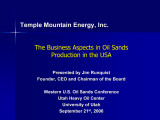TO
Filters: Collection: "ir_eua" Subject: "Oil"
1 - 25 of 16
| Title | Date | Subject | Description | ||
|---|---|---|---|---|---|
| 1 |
 |
A brief history of early mineral exploitation in the Uinta Basin | 1964 | Uinta Basin; Mining; Uintah Valley; Indian Reservation; Meeker; Utah; History of early mineral exploitation; Uintah Reservation; Gilsonite; Coal; Copper; Iron; Oil shale; Ozocerite; Wurtzilite; Oil; Asphalt; Ashley Creek; Hatchtown; Vernal; Fort Duchesne; Ouray Subagency | Early mining activities in the Uinta Basin can be summarized by saying that they included mining for gilsonite, coal, copper, iron, oil shale, ozocerite, wurtzilite, and oil and asphalt (under the placer mining laws). Of these minerals only coal and gilsonite were produced in commercially significan... |
| 2 |
 |
A model of hydrocarbon generation from type 1 kerogen: Application to the Uinta Basin, Utah | 1986-12-18 | Pyrolysis; Green River shale; Petroleum; Utah; Uinta Basin; Kerogen; Oil; Eocene; Type I kerogen; Hydrocarbon generation; Oil generation; Gas generation; Kinetics | The Uinta Basin in northeastern Utah provides an ideal setting to study the evolution of kerogen to petroleum. Oil shale rocks of the Eocene-age Green River Formation outcrop extensively at the southern edge of the synclinal basin. The same rocks are also found at depths of 3650 m in the deepest par... |
| 3 |
 |
A proposal to evaluate oil-impregnated sandstone in the Uinta Basin, northeast Utah; made to the Energy Research and Development Administration by Utah Geological and Mineral Survey | 1976-06-15 | Petroleum; Utah; Uinta Basin; Oil; Bitumen; Ore waste radiation; Oil-impregnated sandstone; Deposits | Most of the known petroleum resources in the form of oil-impregnated in the United States occur in Utah. It is estimated that over ten billion barrels of petroleum occur in such deposits in the Uinta Basin alone (Ritzma, 1973; Campbell, 1975). Four deposits among the twenty identified in the Uinta ... |
| 4 |
 |
A reconnaissance evaluation of heavy hydrocarbons in the Tar Sand Triangle | 1985-08 | Utah; Tar Sand Triangle; Permian White Rim Sandstone; Moenkopi Formation; Cedar Mesa Sandstone; Chinle Formation; Oil; Oil-impregnated sandstone deposit; In-situ; Heavy hydrocarbons; Triassic; Jurassic Navajo Sandstone | The Tar Sand Triangle encompasses about 200 square miles in southeastern Utah. The area consists of rough, mountainous terrain, with a climate that varies from semiarid to arid. Sedimentary rocks exposed in the area range from Permian Cedar Mesa Sandstone to the Triassic(?)-Jurassic Navajo Sandstone... |
| 5 |
 |
A solvent extraction process for tar sand | 1987 | Sunnyside, Utah; Tar sand; Solvent extraction; Bitumen; East central Utah; Ore; Hydrocyclones; Pentane-deasphaltening; Rotary kiln steam strippers; Oil | A process has been investigated for solvent extraction of bitumen from Sunnyside, Utah, tar sands. The Sunnyside deposit, in east central Utah, has 1 to 2 billion barrels of geological reserves with a richness of 6 to 10 wt% bitumen. In this process, the ore is crushed and the bitumen is dissolved f... |
| 6 |
 |
Ambient froth flotation process for the recovery of bitumen from tar sand | 1984-01-10 | Patent; Bitumen; Tar sand; Admixing raw tar sand; Tar sand slurry; Milling; Froth flotations; Ambient temperatures; Concentrated bitumen tar sand product; Oil; Recycle and recovery | A method for upgrading the bitumen content of tar sands, wherein a raw tar sand slurry admixture of tar sands, water, collectors, and dispersing/wetting agents is milled; conditioned and then separated by a series of froth flotations at ambient temperatures from about 2.degree. C. to about 25.degree... |
| 7 |
 |
An assessment of oil shale and tar sand development in the state of Utah: Phase 2--policy analysis | 1982 | Oil shale; Tar sand development; Utah; Synthetic fuels; Uintah Basin; Northeastern Utah; Petroleum reserves; Tar sand; Oil; Synthetic Fuel commercialization viability | The potential development of synthetic fuels in the United States has been characterized by a great variation in preceived economies. The interest has been on an upswing during the decade of the 1970's due to the possibility of synthetic fuels lessening U.S. dependence on foreign oil. However, even ... |
| 8 |
 |
APPENDIX C - In-situ production of Utah oil sands - Final Project Report - Reporting period: June 21, 2006 to October 21, 2009 | 2009-10 | Utah; Uinta Basin; Oil sand reservoirs; Whiterocks; Sunnyside; Oil; Oil extraction; In-situ; Heavy oil production; Bitumen | Two oil sand reservoirs located in Utah's Uinta Basin were considered for analysis: Whiterocks, a small, steeply dipping, contained reservoir containing about 100 million barrels, and Sunnyside, a giant reservoir containing over four billion barrels of oil in place. Cyclic steam stimulation, steam a... |
| 9 |
 |
Assay products from Green River oil shale | 1986-02-18 | Pyrolysis stoichiometry; Green River; Oil shale; Oil; Mahogany zone; Colorado; Utah; Pairwise correlation coefficients; Pyrolysis; Elemental analyses of shales and oils; Organic carbon; Gas composition; Elemental composition; Oil shale grade; Raw shale | Data from 66 material-balanced assays conducted at Lawrence Livermore National Laboratory, Laramie Energy Technology Center, and The Oil shale Corporation were compiled and analyzed to determine the pyrolysis stoichiometry for Green River formation oil shales originating in and near the Mahogany zon... |
| 10 |
 |
Basin oriented strategies for CO2 enhanced oil recovery: Alaska | 2005-04 | Alaska; North Slope; Cook Inlet; Oil; Gas; Oil recovery; EOR; CO2; Carbon dioxide; Oil fields; Oil production industry | The oil and gas producing regions of Alaska have nearly 45 billion barrels of oil which will be left in the ground, or "stranded", following the use of today's oil recovery practices. A major portion of this "stranded oil" is in reservoirs technically and economically amenable to enhanced oil recove... |
| 11 |
 |
Basin oriented strategies for CO2 enhanced oil recovery: Rocky Mountain Region | 2006-02 | Rocky Mountain; Colorado; Utah; Wyoming; Oil; Gas; Enhanced oil recovery; EOR; CO2; Carbon dioxide injection; Oil fields; Basin oriented strategies; Domestic oil production | The Rocky Mountain oil and gas producing region of Colorado, Utah and Wyoming has an original oil endowment of nearly 34 billion barrels. Of this, 11 billion barrels (33%) has been produced or proven. As such, nearly 23 billion barrels of oil will be left in the ground, or "stranded", following the ... |
| 12 |
 |
Basin-wide evaluation of the uppermost Green River Formation's oil-shale resource, Uinta Basin, Utah and Colorado | 2008 | Green River; Uinta Basin; Utah; Colorado; Crude oil; Green River Formation; Oil; Gas; Oil yield; Oil shale; Oil-shale thickness; Mahogany zone; R-7; Parachute Creek Member; Richness grade; Uintah County; Salt Lake Base Line and Meridian; BLM; U.S. Bureau of Land Management | Due to the recent increase in crude oil prices and concerns over diminishing conventional reserves, the Utah Geological Survey has reexamined the Uinta Basin's oil-shale resource, primarily in the Mahogany zone of the Green River Formation. Past assessments, the first conducted in 1964 and subsequen... |
| 13 |
 |
Business aspects in oil sands production in the USA | 2006-09-21 | Temple Mountain Energy; Oil sand production; Oil; Natural gas; Electricity; Oil prices; Heavy oil; Oil sands; Business; Economic; SAGD; Steam assisted gravity drainage | The world economic challenge: What is the most important economic resource known? 1-Energy production-Oil, natural gas and electricity are the biggest players 2-China and India economic development (2/3rds of world)-Huge unexpected demands for these resources (now and future)-Especially oil-Fuels, a... |
| 14 |
 |
CRS report for Congress: Developments in oil shale | 2008-11-17 | Green River; Oil shale formation; Colorado; Utah; Wyoming; Oil; Oil shale; Diesel; Jet fuel; Department of Energy; DOE; Synthetic fuels; Petroleum; Energy Policy Act of 2005; EPAct; BLM; Oil research, development, and demonstration; RD&D; Programmatic Environmental Impact Statement; PEIS; Oil shale ... | The Green River oil shale formation in Colorado, Utah, and Wyoming is estimated to hold the equivalent of 1.38 trillion barrels of oil equivalent in place. The shale is generally acknowledged as a rich potential resource; however, it has not generally proved to be economically recoverable. Thus, it ... |
| 15 |
 |
Downhole hydraulic mining system | 1985-07-31 | Oil-bearing sands; Oil field; Wellbore; Downhole hydraulic mining system; California; Utah; Kentucky; New Mexico; Canada; Venezuela; Oil; Deposits; Strip mining | The downhole hydraulic mining system is designed to exploit deposits of oil-bearing sands that are not economically producible using current oil field or mining technology. In most cases, the hydrocarbon in the reservoir is too viscous to flow into the wellbore naturally and applications of heat (st... |
| 16 |
 |
Economic impacts of U.S. liquid fuel mitigation options | 2006-07-08 | Oil; Oil shortages; United States dependence on oil imports; Energy Security; Vehicle fuel efficiency (VFE); Coal liquefaction; Coal-to-liquids (CTL); Oil shale; Enhanced oil recovery (EOR); Oil peaking; Liquid fuels | The world is consuming more oil than it is finding, and at some point within the next decade or two, world production of conventional oil will likely peak. Peaking will lead to shortages and greatly increased prices and price volatility. In addition to peaking and its consequences, there are widespr... |
1 - 25 of 16
